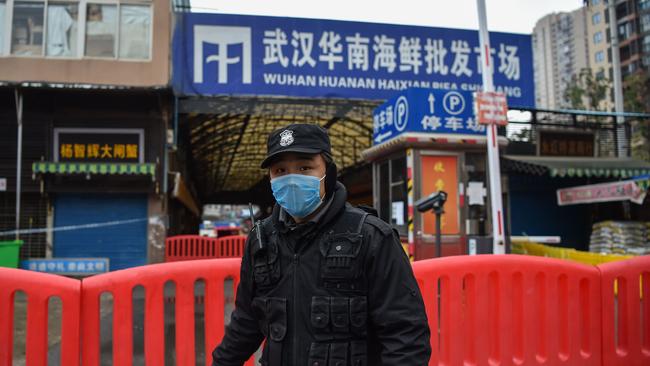Part three: China’s great wall of silence: A Noah’s ark of wild animals
The earliest reported patient infected with what was later named COVID-19 was found in Hubei on November 17.

This is the third part of our investigation by Cameron Stewart and Will Glasgow on China and the coronavirus. Read part one and part two here.
The earliest reported patient infected with what was later named COVID-19 was found in Hubei on November 17, according to a report in the South China Morning Post, the masthead owned by China’s richest man, Jack Ma, the Alibaba billionaire who is perhaps the Communist Party’s most famous member after Xi.
That was more than nine weeks before Wuhan, a city with a population of 11 million people, was put into lockdown on January 23. It was the biggest quarantine in history, until the next day when almost all of Hubei province, with its population of almost 60 million, was cut off from China and the rest of the world. It was a dramatic example of the power of China’s centralised political system. But did it come too late?
Identifying a new virus is always going to be a challenge for the first hospital system that encounters it. Doctors and disease experts in Wuhan, however, were aware that the public comments by local officials did not match their experience. Far more patients were arriving in their hospitals with symptoms of the new illness than was being disclosed. Many regret not speaking out after Li and the seven other “rumour spreaders” were punished. “We should have taken the risk,” Li Yunhua, a radiologist at the Hubei Xinhua Hospital in Wuhan, told Caixin, a Chinese media outfit with a well-deserved reputation for delicately treading around the instructions of the Central Propaganda Department.
These health workers were operating within a system that valued “political stability” over their professionalism. That much was put in writing in June 2018, as hospitals were moved under the control of their Chinese Communist Party secretary.
The new arrangement, announced by Xinhua, was required “to thoroughly implement Xi Jinping’s socialist thought with Chinese characteristics in the new era”. It was to “give full play to the leading role of the party committee of public hospitals”.
Less than two years later, what looked like an arcane internal matter overseen by China’s secretive governing party has changed the world. In part, it explains why Ai was reprimanded for looking into the new infectious disease. She had not taken appropriate “political” consideration. It is an arrangement that China’s government likely does not want an independent review to have a close look at.
The same goes for the guiding role of Wuhan’s government on its hospital system, which obediently reported very few cases of the highly infectious new disease between January 5 and January 16, a period leading up to and including the province’s two most important annual political meetings.

The relationship between the provincial and municipal governments and the powerful centre is another point of discomfort. In an interview on state media on January 27, days into Wuhan’s extraordinary lockdown which ultimately ran for more than two months, the city’s mayor, Zhou Xianwang, said China’s centralised political system did not allow him to reveal the true situation. “As a local government, we need to get authorisation before disclosure,” he said in an interview broadcast on China Central Television.
Then there are the destroyed samples of the virus. Caixin reported that on January 3, China’s National Health Commission, the country’s top health authority, ordered institutions in Wuhan not to publish any information related to the unknown disease and to destroy samples of the disease. The report apparently so upset the government that it was removed from Caixin’s website.
Some in Washington, including Pompeo and Donald Trump’s Mandarin-speaking Deputy National Security Adviser, Matt Pottinger, are increasingly keen to snoop around Wuhan’s virology labs. But the more orthodox interest remains in the world’s most famous “seafood” market, which also traded a Noah’s ark of wild animals, including snakes, hares, pheasants, giant salamanders and crocodiles. While the sale of many of those wild animals is officially banned, vendors told Caixin the trade has continued untroubled in the market’s western corner for the past decade.
‘How can we resolve the case without evidence? Tracing the pathogen is a complicated process’
But even if an investigation team were given access, it is not clear what they could learn. On the day before Ai was told off, a clean-up squad was sent in to disinfect and shutter the place — evidence the Chinese system was taking the situation seriously, in its idiosyncratic way. It has hugely undermined the effort to establish how the virus emerged.
“The market was closed, cleaned up, and the crime scene was gone,” said Guan Yi, director of the State Key Laboratory of Emerging Infectious Disease at the University of Hong Kong.
“How can we resolve the case without evidence? Tracing the pathogen is a complicated process. We can’t just find an infected animal and determine that was the origin.”
After being delayed more than two weeks, the WHO’s joint mission on COVID-19 was finally allowed entry into China in mid-February. The mission was led by Bruce Aylward, a Canadian epidemiologist, who in a notorious television interview in March refused to answer a question about Taiwan, apparently concerned about how Beijing would respond.
Only “select members” of the 25 visiting experts were allowed to go to Wuhan for the final two days of their eight-day site visit. The published itinerary shows they were kept away from the market.
Part four: China’s great wall of silence: ‘The situation has changed radically’
